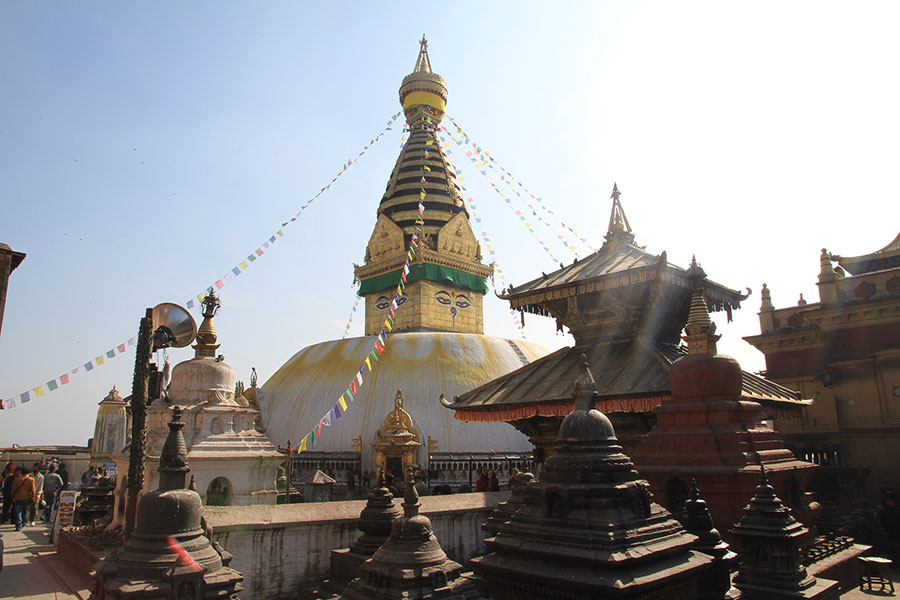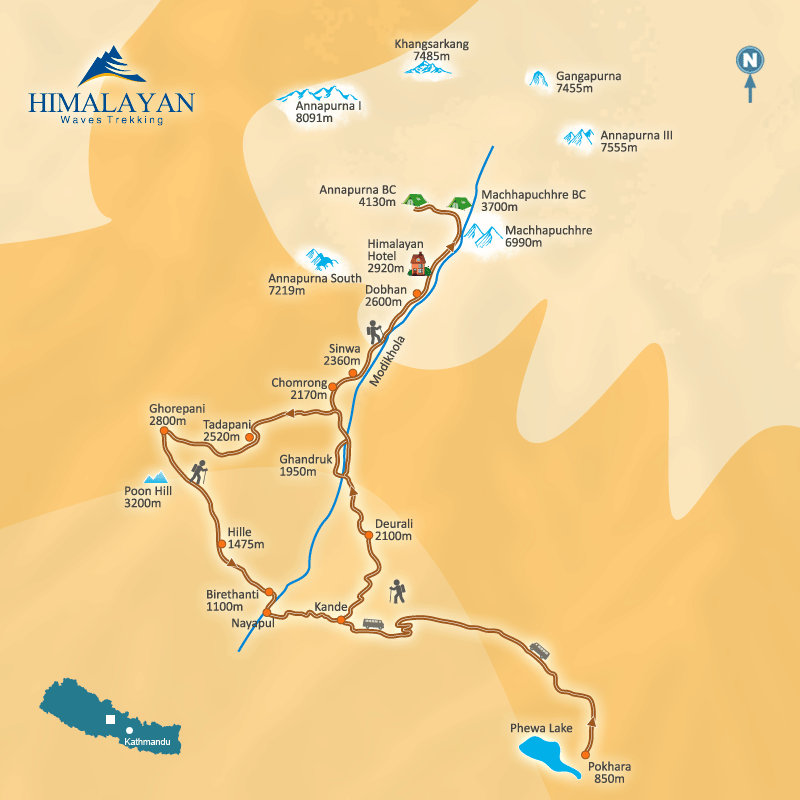-
SeasonsSpring / Summer / Autumn
Annapurna Base Camp Trek
-
Seasons:Spring / Summer / Autumn
Annapurna Base Camp Trek
Overview

Trip Fact
Price
Duration
Altitude
Group Size
Accommodation
Trip Start From
Trip Ends At
Why Choose This Trip?
1. Into the Heart of the Annapurnas
Imagine standing in a natural amphitheater of giants—surrounded on all sides by snowcapped peaks like Annapurna I (8,091m), Machapuchare (the sacred “Fishtail” peak), Hiunchuli, and Gangapurna.
That’s Annapurna Base Camp. It’s not just a destination—it’s an experience that stirs the soul. As the sun rises, the entire sanctuary bathes in gold, and for a moment, the world feels silent, sacred, and impossibly beautiful.
2. A Trail of Ever-Changing Landscapes
The Annapurna Base Camp Trek is like walking through an epic movie, scene by scene. You’ll pass through lush terraced fields, subtropical forests, and quiet Gurung villages. As you gain altitude, the terrain shifts—bamboo groves give way to high alpine meadows, and waterfalls tumble down sheer cliffs.
One minute you’re surrounded by blooming rhododendrons; the next, you’re tracing glacial streams under a sky of stars. Every day is different, and every view feels like a reward.
3. Culture, Connection & Himalayan Hospitality
This isn’t just a trek—it’s a chance to connect. The villages along the route, like Chhomrong, Ghandruk, and Sinuwa, are home to the warm and welcoming Gurung people.
You’ll stay in cozy teahouses, share stories over hot dal bhat, and hear traditional songs echo through the hills. Whether it’s a local guide explaining mountain lore or a teahouse owner sharing ginger tea, the human warmth here is just as memorable as the views.
4. Machapuchare: The Silent Guardian
While Annapurna I may be the highest, Machapuchare steals the spotlight. Its twin-peaked summit is off-limits to climbers—revered as the home of the god Shiva—and it watches over the trail like a sacred sentinel.
As you ascend toward the base camp, this holy mountain seems to follow you, changing shape with every bend in the path. By the time you reach its shadow, you’ll understand why locals call it “unclimbable” and divine.
5. A Balanced Adventure—Challenging Yet Achievable
The ABC trek strikes a perfect balance: it’s physically rewarding, but doesn’t require technical skills or extreme endurance. Over 7–11 days, you’ll gain altitude gradually, giving your body time to adjust and your mind time to take it all in.
It’s ideal for both first-timers and seasoned trekkers looking for a deeply immersive Himalayan journey—one where effort meets elevation, and awe meets accomplishment.
Trip At Glance
Brief Itinerary
-
Day 01:Arrival in Kathmandu, meet at the airport and transfer to Hotel
-
Day 02:Flight or Drive Kathmandu to Pokhara by tourist bus, transfer to Hotel
-
Day 03:Drive Pokhara to Kande by car, Start Trek, overnight at Deorali (2100 m)
-
Day 04:Ghandruk (1950 m)
-
Day 05:Sinuwa (2360 m)
-
Day 06:Himalaya (2920 m)
-
Day 07:Machhapuchare Base Camp (3700 m)
-
Day 08:Annapurna Base Camp (4130 m)
-
Day 09:Dobhan (2600 m)
-
Day 10:Chhomrong (2170 m)
-
Day 11:Tadapani (2520 m) via Gurajun
-
Day 12:Gorepani (2800 m)
-
Day 13:Sunrise View from Poon Hill (3200 m), Trek to Hille (1475 m)
-
Day 14:Birethanti (1100m), drive Nayapul to Pokhara (850m) by car and enjoy the Phewa Lake
-
Day 15:Flight or Drive Pokhara to Kathmandu by tourist bus and evening farewell dinner.
-
Day 16:Departure to connect next destination or you may extend the trip as per your desire and time
Detailed Itinerary
Day 1: Arrival in Kathmandu, meet at the airport and transfer to Hotel
Touch down at Tribhuvan International Airport and transfer to your hotel. Enjoy the evening at your leisure, perhaps explore the vibrant streets of Thamel, recharge with Nepali cuisine, and prepare mentally for your upcoming Himalayan adventure.

Day 2: Transfer to Pokhara
Relax in comfort as you either fly or drive to Pokhara (≈ 822 m). On arrival, check into your riverside hotel. The rest of your day is free consider a walk along Phewa Lake or relaxing in a lakeside café with panoramic views of snow-capped peaks.
Day 3: Pokhara → Kande → Trek to Deorali (~2,100 m)
Embark on an early car ride to Kande, where your trek officially begins. The trail ascends gradually through forested slopes and terraced farms before reaching Deorali (≈ 2,100 m). Spend the evening under stars, immersed in the sounds of rural Nepal.
Day 4: Deorali → Ghandruk (~1,950 m)
Descend to Ghandruk, a charming Gurung village rich in culture and mountain hospitality. Home to the local Gurung Museum, this overnight stop offers views of Annapurna South, Hiunchuli, and Fishtail.
Day 5: Ghandruk → Sinuwa (~2,360 m)
Continue your ascent through rhododendron forests and across seasonal streams, arriving at Sinuwa, nestled in a steep valley. Expect to hike 5–7 hours today, with beautiful variations in terrain and ample opportunities to pause amidst bird songs and forest shade.
Day 6: Sinuwa → Himalaya (~2,920 m)
Climb steadily through mountain forests toward Himalaya, a serene meadow settlement. As altitude increases, the air crisps and views of forests give way to rocky mountain skyline.
Day 7: Himalaya → Machhapuchare Base Camp (~3,700 m)
Ascend toward Machhapuchare Base Camp, nestled beneath the dramatic Fishtail (Machhapuchare) peak. At around 3,700 m, the panorama begins to feel alpine—snow-sprinkled ridges, glacial fields, and peaks towering overhead.
Day 8: VMachhapuchare Base Camp → Annapurna Base Camp (~4,130 m)
Achieve the trek’s pinnacle! Reach Annapurna Base Camp (≈ 4,130 m) with sweeping 360° views of Annapurna I, Gangapurna, Hiunchuli, and more. The icy amphitheater that surrounds you is humbling.
Day 9: ABC → Dobhan (~2,600 m)
Begin descent via Bamboo and Dovan, ending the day in Dobhan—a tranquil high-altitude meadow below the shores of the mountain sanctuary.
Day 10: Dobhan → Chhomrong (~2,170 m)
Continue descending through rhododendron groves before re-entering charming mountain settlements. Finally reach Chhomrong, a vibrant village known for its scenic views and hospitable tea-houses.
Day 11: Chhomrong → Tadapani (~2,520 m) via Gurajun
Ascend once more through forests to Tadapani, with optional detours to traditional hamlets like Gurajun, showcasing regional architectural styles and forested panoramas.
Day 12: Tadapani → Gorepani (~2,800 m)
A gentle climb enveloped in rhododendron forests leads you to Gorepani, perched on a ridge with sunset views across the Annapurna massif.
Day 13: Sunrise at Poon Hill (~3,200 m) → Hille (~1,475 m)
Rise before dawn to hike to Poon Hill (≈ 3,210 m)—the trek’s most iconic sunrise vista, bathing Annapurna, Dhaulagiri, and Machhapuchare towers in golden glow. Return to Gorepani for breakfast, then descend through forests and terraced villages to Hille.
Day 14: Hille → Birethanti (1,100 m), Drive to Pokhara
Continue descent to Birethanti, where a vehicle awaits for transfer back to Pokhara. Wind down the day with boating on Phewa Lake or visit local cafes to relax beside the water.
Day 15: Return to Kathmandu & Farewell Dinner
Choose a scenic drive or flight back to Kathmandu. In the evening, celebrate your journey with a traditional farewell dinner, featuring Nepalese music, cuisine, and storytelling.
Day 16: Departure or Extension
Enjoy a final morning in Kathmandu before your departure, or extend your stay to explore destinations like Chitwan, Lumbini, or make room for more Himalayan adventures.
Package Details
Cost Includes:
- Airport arrival and departure private transfer
- 2 nights accommodation in Kathamndu with breakfast on twin share basis
- 2 nights accommodation in Pokhara with breakfast on twin share basis
- Kathmandu – Pokhara – Kathmandu transfer by tourist bus
- Pokhara – Kande and Nayapul – Pokhara by private car
- 11 nights full board (BLD) teahouse trek with accommodation in mountain lodge
- An english speaking trekking guide and porters from Lukla (2 guests = 1 Porter & Max 25 kg)
- ACAP Permit & TIMS (required passport copy and 3 picture for permit).
- Farewell dinner with Nepalese cultural dance show
Cost Excludes:
- Personal nature of expenses and trekking gears
- Kathmandu – Pokhara – Kathmandu airfare, airport taxes and excess baggage fee ( 20KG free)
- Travel Insurance for rescue operation if any form
- Extra night accommodation or accommodation if earlier return from trekking by any reason
- Extra cost occur by any reason which is not in our control such as strike, landslide and accident etc
- TIPS for trekking staffs and other things which is not included above.
To Do’s In Kathmandu
- Walk Through History at UNESCO Sites
Kathmandu Valley offers an unforgettable journey through history with UNESCO World Heritage Sites like Swayambhunath, Boudhanath, Pashupatinath, and the ancient Durbar Squares—each filled with rich culture, architecture, and spiritual depth. - Shop, Eat & People-Watch in Thamel
Thamel is the buzzing heart of Kathmandu where you can shop for trekking gear, local crafts, and books, or relax in rooftop cafés and enjoy a wide mix of global and local food. - Taste the Real Nepal (Beyond Dal Bhat)
Kathmandu’s food scene delivers everything from juicy momos and traditional Newari dishes to hearty Thakali thalis, making it a top spot for tasting Nepal’s diverse culinary flavors. - Easy Day Trips When You Need a Break from the Buzz
Short escapes to places like Bhaktapur, Nagarkot, Dhulikhel, or Chandragiri offer peaceful views, cultural depth, and refreshing air—all within a quick drive from the city. - Recover, Recharge & Just Chill
After a trek or long journey, Kathmandu is perfect for recovery with spas, yoga studios, serene gardens, and rooftop lounges that help you unwind at your own pace.
FAQs
Plan your Trip
Sangeeta Bhandari
sangeeta@himalayanwavestrekking.com
Quick Inquiry
Write Your Review
We’d love to hear your thoughts! Please leave a star rating and share your review of this trek.












